ATMC BUS 704 Corporate Finance Assignment: Solutions and Analysis
VerifiedAdded on 2022/09/27
|12
|1524
|19
Homework Assignment
AI Summary
This document presents a comprehensive solution to a Corporate Finance assignment. It begins with an analysis of investment decisions, including calculating Net Present Value (NPV) and Internal Rate of Return (IRR) to determine which project maximizes shareholder wealth. The assignment then delves into fundamental financial concepts, such as agency relationships and market efficiency. A significant portion of the solution focuses on debt financing, calculating monthly payments, interest and principal payments, and the amount owed after a certain period, considering both monthly and quarterly payment schedules. Furthermore, it explores bond valuation, determining yield to maturity, coupon yield, and bond prices, including the impact of interest rate changes on bond prices and durations. The solution provides detailed calculations and explanations for each question, offering a thorough understanding of the core concepts in corporate finance.
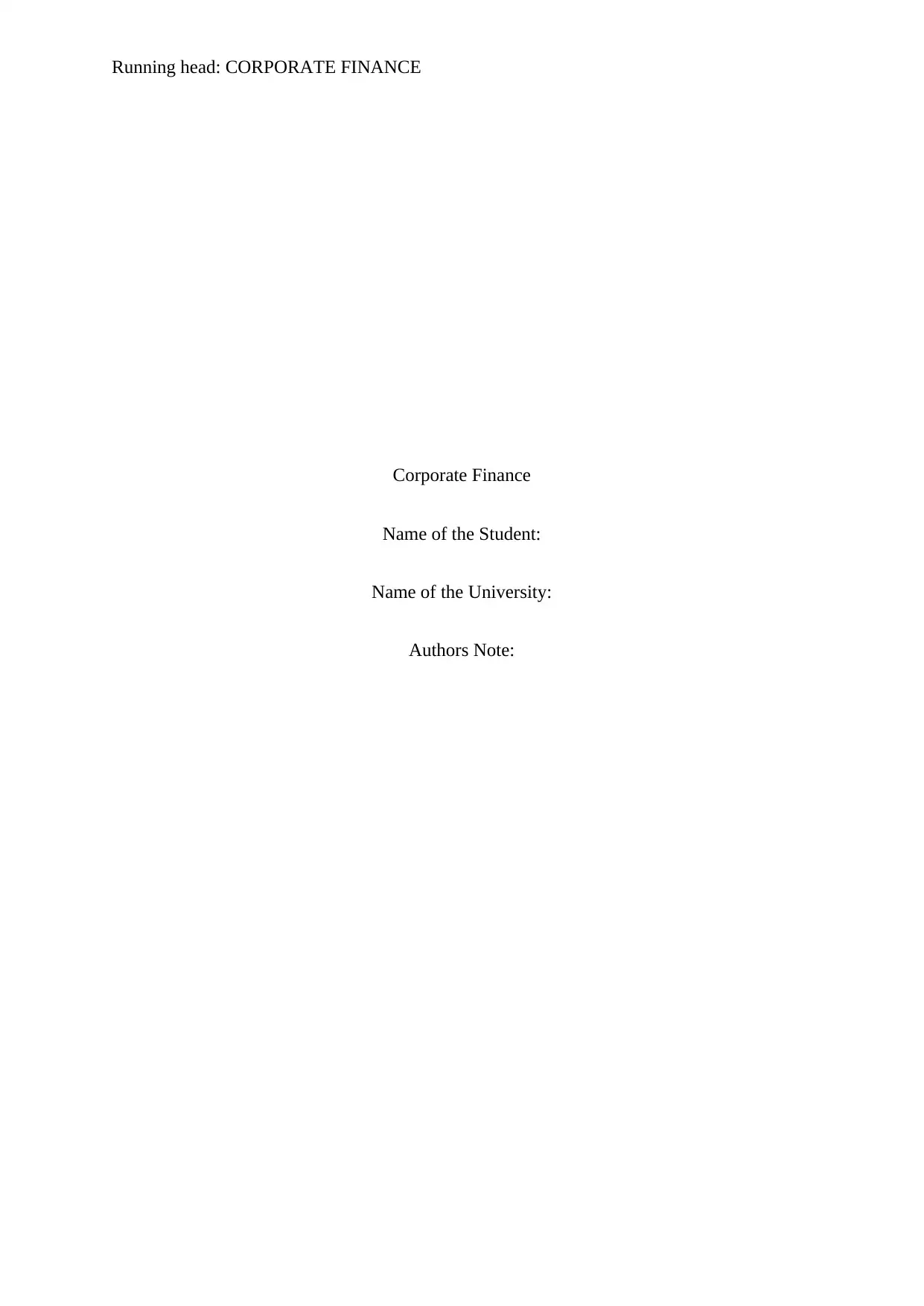
Running head: CORPORATE FINANCE
Corporate Finance
Name of the Student:
Name of the University:
Authors Note:
Corporate Finance
Name of the Student:
Name of the University:
Authors Note:
Paraphrase This Document
Need a fresh take? Get an instant paraphrase of this document with our AI Paraphraser

CORPORATE FINANCE
1
Table of Contents
Question 1:.................................................................................................................................3
a. Indicating the project that maximises shareholder wealth:....................................................3
b. Explaining the relevant reasons:............................................................................................3
Question 2:.................................................................................................................................3
a. Discussion the concept of “agency relationships”:................................................................3
b. Discussing the concept of “market efficiency and asset pricing”:.........................................4
Question 3:.................................................................................................................................4
a. Monthly payment:..................................................................................................................4
b. First interest payment:............................................................................................................4
c. First principal payment:..........................................................................................................4
d. ATMC owe on this loan after making monthly payments for four years:.............................5
e. Present value of this difference:.............................................................................................5
f. Quarterly payments:................................................................................................................5
g. ATMC owe on this loan after making quarterly payments for four years:............................6
h. Annual percentage rate on the original:.................................................................................6
i. Effective annual rate on the original 10 year:.........................................................................6
Question 4:.................................................................................................................................6
a. Bond’s yield to maturity:........................................................................................................6
b. Coupon yield of the bond over the next year:........................................................................7
c. Calculating the bonds worth:..................................................................................................7
d. Interested in buying this bond:...............................................................................................7
e. Gain or loss on this bond since yesterday:.............................................................................7
Question 5:.................................................................................................................................8
a. Calculating the duration of each bond:...................................................................................8
1
Table of Contents
Question 1:.................................................................................................................................3
a. Indicating the project that maximises shareholder wealth:....................................................3
b. Explaining the relevant reasons:............................................................................................3
Question 2:.................................................................................................................................3
a. Discussion the concept of “agency relationships”:................................................................3
b. Discussing the concept of “market efficiency and asset pricing”:.........................................4
Question 3:.................................................................................................................................4
a. Monthly payment:..................................................................................................................4
b. First interest payment:............................................................................................................4
c. First principal payment:..........................................................................................................4
d. ATMC owe on this loan after making monthly payments for four years:.............................5
e. Present value of this difference:.............................................................................................5
f. Quarterly payments:................................................................................................................5
g. ATMC owe on this loan after making quarterly payments for four years:............................6
h. Annual percentage rate on the original:.................................................................................6
i. Effective annual rate on the original 10 year:.........................................................................6
Question 4:.................................................................................................................................6
a. Bond’s yield to maturity:........................................................................................................6
b. Coupon yield of the bond over the next year:........................................................................7
c. Calculating the bonds worth:..................................................................................................7
d. Interested in buying this bond:...............................................................................................7
e. Gain or loss on this bond since yesterday:.............................................................................7
Question 5:.................................................................................................................................8
a. Calculating the duration of each bond:...................................................................................8

CORPORATE FINANCE
2
b. Calculating the percentage change in each bond’s price:......................................................8
c. Commenting on the relationship between bond price sensitivity to interest rates and its
duration:.....................................................................................................................................9
References and Bibliography:..................................................................................................10
2
b. Calculating the percentage change in each bond’s price:......................................................8
c. Commenting on the relationship between bond price sensitivity to interest rates and its
duration:.....................................................................................................................................9
References and Bibliography:..................................................................................................10
⊘ This is a preview!⊘
Do you want full access?
Subscribe today to unlock all pages.

Trusted by 1+ million students worldwide

CORPORATE FINANCE
3
Question 1:
a. Indicating the project that maximises shareholder wealth:
Cash flow ($)
Year Project A Project B
0
-
$2,35,000.00 -$2,35,000.00
1 $1,20,000.00 $10,000.00
2 $1,00,000.00 $50,000.00
3 $60,000.00 $60,000.00
4 $20,000.00 $1,00,000.00
5 $10,000.00 $1,20,000.00
Discount rate 12% 12%
NPV $12,953.69 -$11,861.89
IRR 15.21% 10.42%
Project A will maximise shareholders wealth.
b. Explaining the relevant reasons:
The analysis has mainly indicated Project A has a positive NPV and higher IRR than
discount rate in comparison to Project B.
Question 2:
a. Discussion the concept of “agency relationships”:
Agency relationship is mainly a concept, where the principal gives legal authority to
an agent for acting on their behalf while dealing with the third party. Thus, management is
considered the agent of the shareholders, where all the relevant legal actions are taken by
them to secure the interest of the owners (Damodaran 2016).
3
Question 1:
a. Indicating the project that maximises shareholder wealth:
Cash flow ($)
Year Project A Project B
0
-
$2,35,000.00 -$2,35,000.00
1 $1,20,000.00 $10,000.00
2 $1,00,000.00 $50,000.00
3 $60,000.00 $60,000.00
4 $20,000.00 $1,00,000.00
5 $10,000.00 $1,20,000.00
Discount rate 12% 12%
NPV $12,953.69 -$11,861.89
IRR 15.21% 10.42%
Project A will maximise shareholders wealth.
b. Explaining the relevant reasons:
The analysis has mainly indicated Project A has a positive NPV and higher IRR than
discount rate in comparison to Project B.
Question 2:
a. Discussion the concept of “agency relationships”:
Agency relationship is mainly a concept, where the principal gives legal authority to
an agent for acting on their behalf while dealing with the third party. Thus, management is
considered the agent of the shareholders, where all the relevant legal actions are taken by
them to secure the interest of the owners (Damodaran 2016).
Paraphrase This Document
Need a fresh take? Get an instant paraphrase of this document with our AI Paraphraser

CORPORATE FINANCE
4
b. Discussing the concept of “market efficiency and asset pricing”:
Market efficiency directly reflects on the degree, where market prices reflect all
available information provided for a particular stock. The asset pricing is a concept, where
relevant information are taken into consideration by the investors to determine the overall
prices of a stock. Thus, the combination of both market efficiency and asset pricing allow the
investors to derive the relevant share price of a stock traded in the market (Ehrhardt and
Brigham 2016).
Question 3:
a. Monthly payment:
Particulars Value
Bank loan $ 2,50,00,000.00
Time 10
Interest rate 6.50%
PMT $ 2,83,869.94
b. First interest payment:
Particulars Value
Bank loan $ 2,50,00,000.00
Time 10
Interest rate 6.50%
PMT $ 2,83,869.94
Interest $ 1,35,416.67
c. First principal payment:
Particulars Value
Bank loan $ 2,50,00,000.00
Time 10
Interest rate 6.50%
PMT $ 2,83,869.94
4
b. Discussing the concept of “market efficiency and asset pricing”:
Market efficiency directly reflects on the degree, where market prices reflect all
available information provided for a particular stock. The asset pricing is a concept, where
relevant information are taken into consideration by the investors to determine the overall
prices of a stock. Thus, the combination of both market efficiency and asset pricing allow the
investors to derive the relevant share price of a stock traded in the market (Ehrhardt and
Brigham 2016).
Question 3:
a. Monthly payment:
Particulars Value
Bank loan $ 2,50,00,000.00
Time 10
Interest rate 6.50%
PMT $ 2,83,869.94
b. First interest payment:
Particulars Value
Bank loan $ 2,50,00,000.00
Time 10
Interest rate 6.50%
PMT $ 2,83,869.94
Interest $ 1,35,416.67
c. First principal payment:
Particulars Value
Bank loan $ 2,50,00,000.00
Time 10
Interest rate 6.50%
PMT $ 2,83,869.94
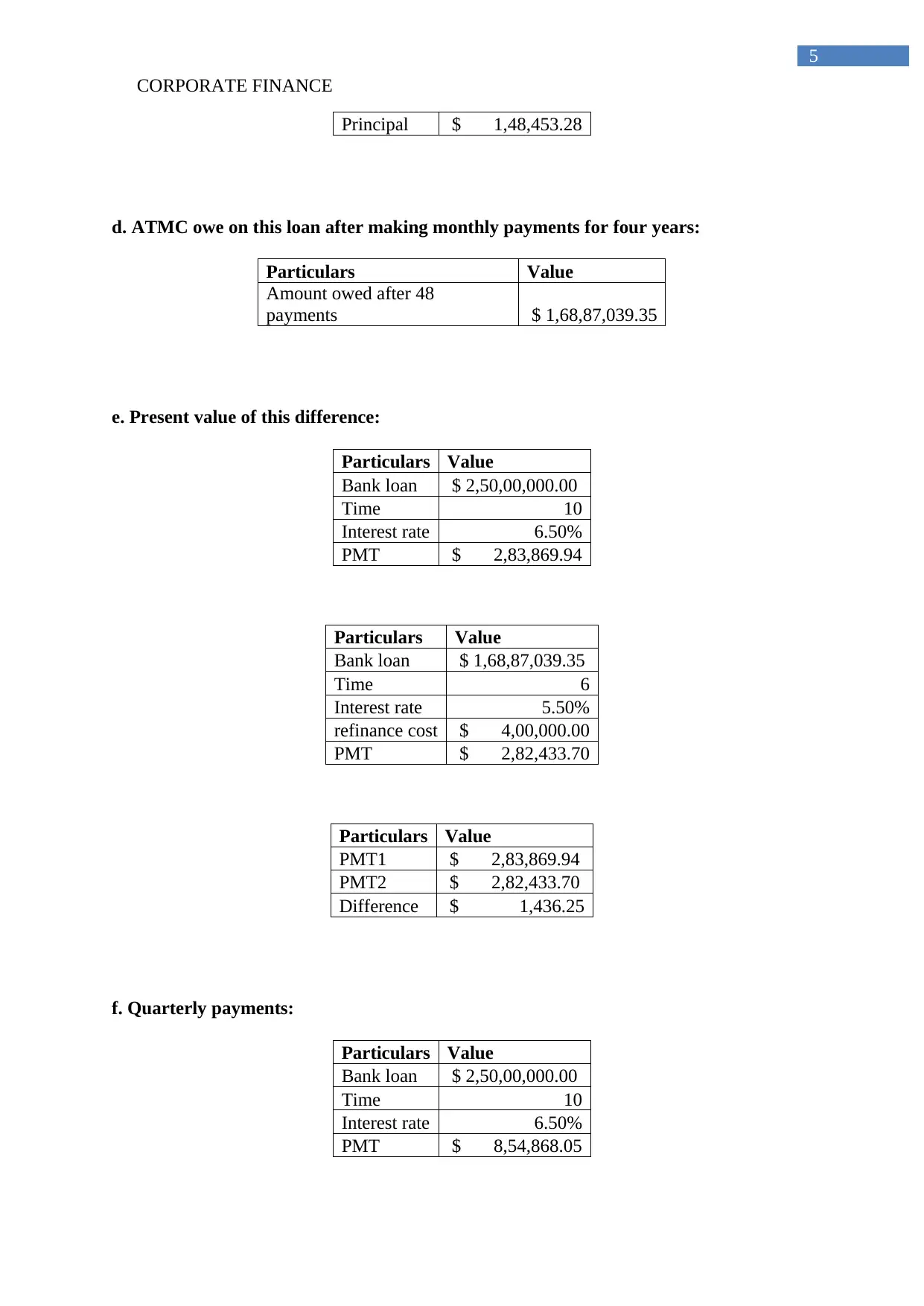
CORPORATE FINANCE
5
Principal $ 1,48,453.28
d. ATMC owe on this loan after making monthly payments for four years:
Particulars Value
Amount owed after 48
payments $ 1,68,87,039.35
e. Present value of this difference:
Particulars Value
Bank loan $ 2,50,00,000.00
Time 10
Interest rate 6.50%
PMT $ 2,83,869.94
Particulars Value
Bank loan $ 1,68,87,039.35
Time 6
Interest rate 5.50%
refinance cost $ 4,00,000.00
PMT $ 2,82,433.70
Particulars Value
PMT1 $ 2,83,869.94
PMT2 $ 2,82,433.70
Difference $ 1,436.25
f. Quarterly payments:
Particulars Value
Bank loan $ 2,50,00,000.00
Time 10
Interest rate 6.50%
PMT $ 8,54,868.05
5
Principal $ 1,48,453.28
d. ATMC owe on this loan after making monthly payments for four years:
Particulars Value
Amount owed after 48
payments $ 1,68,87,039.35
e. Present value of this difference:
Particulars Value
Bank loan $ 2,50,00,000.00
Time 10
Interest rate 6.50%
PMT $ 2,83,869.94
Particulars Value
Bank loan $ 1,68,87,039.35
Time 6
Interest rate 5.50%
refinance cost $ 4,00,000.00
PMT $ 2,82,433.70
Particulars Value
PMT1 $ 2,83,869.94
PMT2 $ 2,82,433.70
Difference $ 1,436.25
f. Quarterly payments:
Particulars Value
Bank loan $ 2,50,00,000.00
Time 10
Interest rate 6.50%
PMT $ 8,54,868.05
⊘ This is a preview!⊘
Do you want full access?
Subscribe today to unlock all pages.

Trusted by 1+ million students worldwide

CORPORATE FINANCE
6
g. ATMC owe on this loan after making quarterly payments for four years:
Particulars Value
Amount owed after 16
payments $ 1,68,77,322.31
h. Annual percentage rate on the original:
Particulars Value
Interest rate 6.50%
Time 10
Annual percentage rate 6.69%
i. Effective annual rate on the original 10 year:
Particulars Value
Interest rate 6.50%
Time 10
Effective annual rate 6.69%
Question 4:
a. Bond’s yield to maturity:
Particulars Value Value
Coupon rate 5% 2.50%
FV 1000
Time 10 50.00
Price
981.9
3
Coupon 50 25.00
YTM 2.56%
6
g. ATMC owe on this loan after making quarterly payments for four years:
Particulars Value
Amount owed after 16
payments $ 1,68,77,322.31
h. Annual percentage rate on the original:
Particulars Value
Interest rate 6.50%
Time 10
Annual percentage rate 6.69%
i. Effective annual rate on the original 10 year:
Particulars Value
Interest rate 6.50%
Time 10
Effective annual rate 6.69%
Question 4:
a. Bond’s yield to maturity:
Particulars Value Value
Coupon rate 5% 2.50%
FV 1000
Time 10 50.00
Price
981.9
3
Coupon 50 25.00
YTM 2.56%
Paraphrase This Document
Need a fresh take? Get an instant paraphrase of this document with our AI Paraphraser

CORPORATE FINANCE
7
b. Coupon yield of the bond over the next year:
The relevant analysis has mainly indicated that coupon yield of the bond over the next
year is at 5% per annum.
c. Calculating the bonds worth:
Particulars Value
Coupon 25.00
FV 1000
Time 20.00
YTM 3.25%
Bond Price 890.95
d. Interested in buying this bond:
Yes, at the rate of 6.5% the bond look more attractive for investors, as it would allow
them to increase the relevant returns from investment.
e. Gain or loss on this bond since yesterday:
Particulars Value
Coupon 25.00
FV 1000
Time 20.00
YTM 3.00%
Bond Price 925.61
Market Price 981.93
Loss 56.32
From the relevant analysis, it has been detected that a loss of 56.32 will be incurred on
the bond since yesterday.
7
b. Coupon yield of the bond over the next year:
The relevant analysis has mainly indicated that coupon yield of the bond over the next
year is at 5% per annum.
c. Calculating the bonds worth:
Particulars Value
Coupon 25.00
FV 1000
Time 20.00
YTM 3.25%
Bond Price 890.95
d. Interested in buying this bond:
Yes, at the rate of 6.5% the bond look more attractive for investors, as it would allow
them to increase the relevant returns from investment.
e. Gain or loss on this bond since yesterday:
Particulars Value
Coupon 25.00
FV 1000
Time 20.00
YTM 3.00%
Bond Price 925.61
Market Price 981.93
Loss 56.32
From the relevant analysis, it has been detected that a loss of 56.32 will be incurred on
the bond since yesterday.
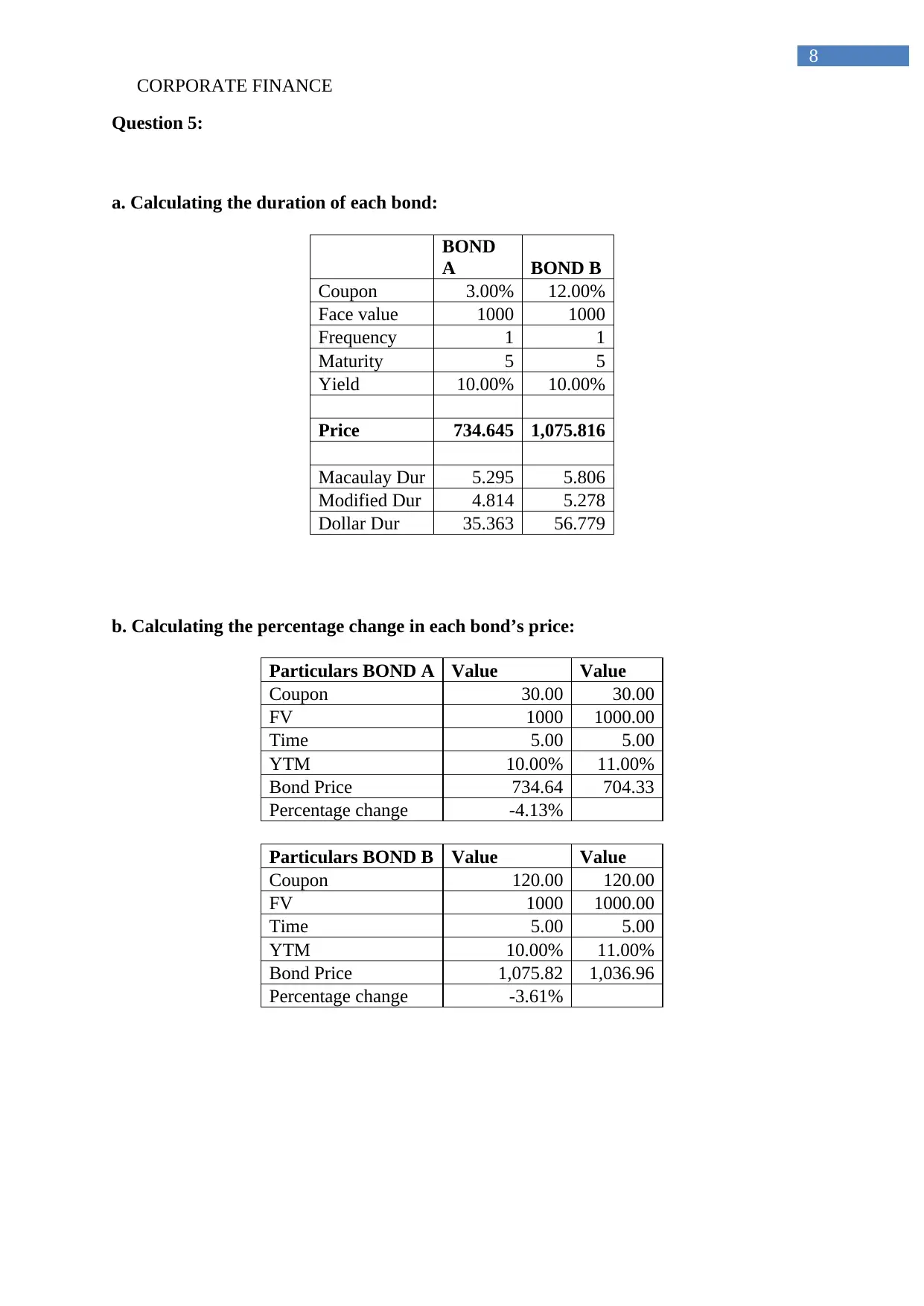
CORPORATE FINANCE
8
Question 5:
a. Calculating the duration of each bond:
BOND
A BOND B
Coupon 3.00% 12.00%
Face value 1000 1000
Frequency 1 1
Maturity 5 5
Yield 10.00% 10.00%
Price 734.645 1,075.816
Macaulay Dur 5.295 5.806
Modified Dur 4.814 5.278
Dollar Dur 35.363 56.779
b. Calculating the percentage change in each bond’s price:
Particulars BOND A Value Value
Coupon 30.00 30.00
FV 1000 1000.00
Time 5.00 5.00
YTM 10.00% 11.00%
Bond Price 734.64 704.33
Percentage change -4.13%
Particulars BOND B Value Value
Coupon 120.00 120.00
FV 1000 1000.00
Time 5.00 5.00
YTM 10.00% 11.00%
Bond Price 1,075.82 1,036.96
Percentage change -3.61%
8
Question 5:
a. Calculating the duration of each bond:
BOND
A BOND B
Coupon 3.00% 12.00%
Face value 1000 1000
Frequency 1 1
Maturity 5 5
Yield 10.00% 10.00%
Price 734.645 1,075.816
Macaulay Dur 5.295 5.806
Modified Dur 4.814 5.278
Dollar Dur 35.363 56.779
b. Calculating the percentage change in each bond’s price:
Particulars BOND A Value Value
Coupon 30.00 30.00
FV 1000 1000.00
Time 5.00 5.00
YTM 10.00% 11.00%
Bond Price 734.64 704.33
Percentage change -4.13%
Particulars BOND B Value Value
Coupon 120.00 120.00
FV 1000 1000.00
Time 5.00 5.00
YTM 10.00% 11.00%
Bond Price 1,075.82 1,036.96
Percentage change -3.61%
⊘ This is a preview!⊘
Do you want full access?
Subscribe today to unlock all pages.

Trusted by 1+ million students worldwide
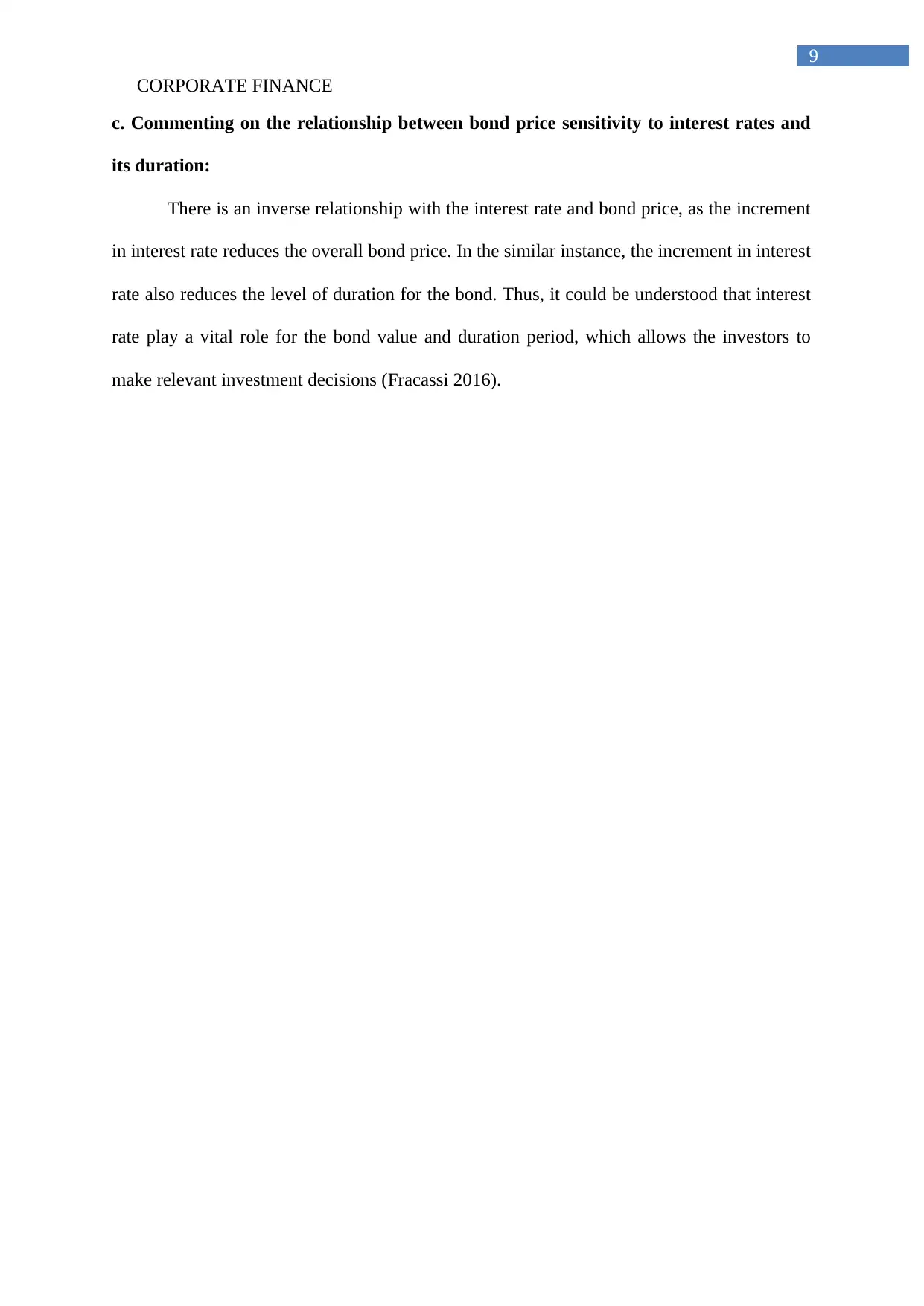
CORPORATE FINANCE
9
c. Commenting on the relationship between bond price sensitivity to interest rates and
its duration:
There is an inverse relationship with the interest rate and bond price, as the increment
in interest rate reduces the overall bond price. In the similar instance, the increment in interest
rate also reduces the level of duration for the bond. Thus, it could be understood that interest
rate play a vital role for the bond value and duration period, which allows the investors to
make relevant investment decisions (Fracassi 2016).
9
c. Commenting on the relationship between bond price sensitivity to interest rates and
its duration:
There is an inverse relationship with the interest rate and bond price, as the increment
in interest rate reduces the overall bond price. In the similar instance, the increment in interest
rate also reduces the level of duration for the bond. Thus, it could be understood that interest
rate play a vital role for the bond value and duration period, which allows the investors to
make relevant investment decisions (Fracassi 2016).
Paraphrase This Document
Need a fresh take? Get an instant paraphrase of this document with our AI Paraphraser

CORPORATE FINANCE
10
References and Bibliography:
Atanasov, V.A. and Black, B.S., 2016. Shock-based causal inference in corporate finance and
accounting research. Critical Finance Review, 5, pp.207-304.
Cheng, B., Ioannou, I. and Serafeim, G., 2014. Corporate social responsibility and access to
finance. Strategic management journal, 35(1), pp.1-23.
Damodaran, A., 2016. Damodaran on valuation: security analysis for investment and
corporate finance (Vol. 324). John Wiley & Sons.
Dang, C., Li, Z.F. and Yang, C., 2018. Measuring firm size in empirical corporate
finance. Journal of Banking & Finance, 86, pp.159-176.
Ehrhardt, M.C. and Brigham, E.F., 2016. Corporate finance: A focused approach. Cengage
learning.
Ferran, E. and Ho, L.C., 2014. Principles of corporate finance law. Oxford University Press.
Foley, C.F. and Manova, K., 2015. International trade, multinational activity, and corporate
finance. economics, 7(1), pp.119-146.
Fracassi, C., 2016. Corporate finance policies and social networks. Management
Science, 63(8), pp.2420-2438.
Hillier, D., Clacher, I., Ross, S., Westerfield, R. and Jordan, B., 2014. Fundamentals of
corporate finance (No. 2nd Eu). McGraw Hill.
Johnson, C.J., McLaughlin, J. and Haueter, E.S., 2015. Corporate finance and the securities
laws. Wolters Kluwer Law & Business.
10
References and Bibliography:
Atanasov, V.A. and Black, B.S., 2016. Shock-based causal inference in corporate finance and
accounting research. Critical Finance Review, 5, pp.207-304.
Cheng, B., Ioannou, I. and Serafeim, G., 2014. Corporate social responsibility and access to
finance. Strategic management journal, 35(1), pp.1-23.
Damodaran, A., 2016. Damodaran on valuation: security analysis for investment and
corporate finance (Vol. 324). John Wiley & Sons.
Dang, C., Li, Z.F. and Yang, C., 2018. Measuring firm size in empirical corporate
finance. Journal of Banking & Finance, 86, pp.159-176.
Ehrhardt, M.C. and Brigham, E.F., 2016. Corporate finance: A focused approach. Cengage
learning.
Ferran, E. and Ho, L.C., 2014. Principles of corporate finance law. Oxford University Press.
Foley, C.F. and Manova, K., 2015. International trade, multinational activity, and corporate
finance. economics, 7(1), pp.119-146.
Fracassi, C., 2016. Corporate finance policies and social networks. Management
Science, 63(8), pp.2420-2438.
Hillier, D., Clacher, I., Ross, S., Westerfield, R. and Jordan, B., 2014. Fundamentals of
corporate finance (No. 2nd Eu). McGraw Hill.
Johnson, C.J., McLaughlin, J. and Haueter, E.S., 2015. Corporate finance and the securities
laws. Wolters Kluwer Law & Business.
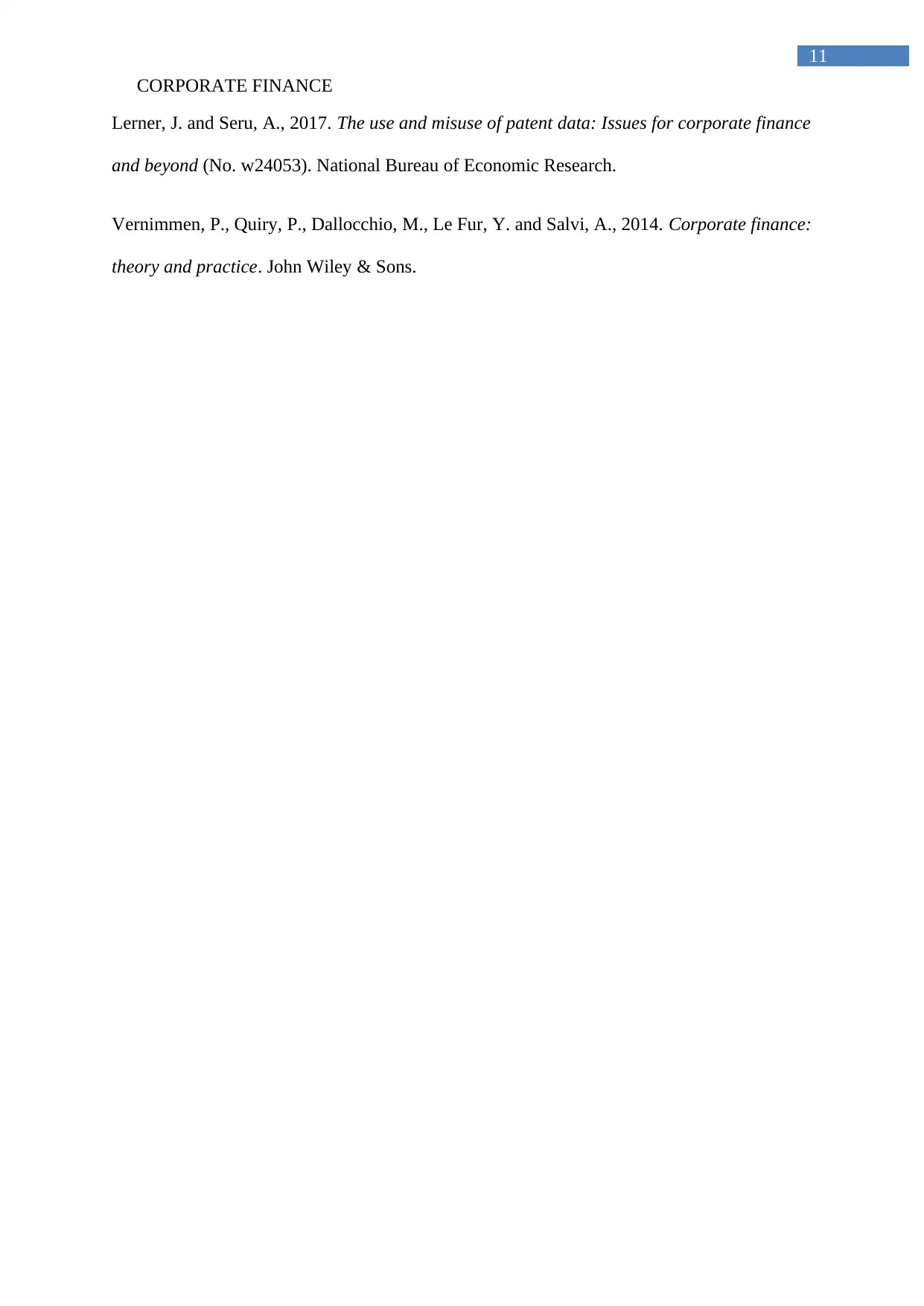
CORPORATE FINANCE
11
Lerner, J. and Seru, A., 2017. The use and misuse of patent data: Issues for corporate finance
and beyond (No. w24053). National Bureau of Economic Research.
Vernimmen, P., Quiry, P., Dallocchio, M., Le Fur, Y. and Salvi, A., 2014. Corporate finance:
theory and practice. John Wiley & Sons.
11
Lerner, J. and Seru, A., 2017. The use and misuse of patent data: Issues for corporate finance
and beyond (No. w24053). National Bureau of Economic Research.
Vernimmen, P., Quiry, P., Dallocchio, M., Le Fur, Y. and Salvi, A., 2014. Corporate finance:
theory and practice. John Wiley & Sons.
⊘ This is a preview!⊘
Do you want full access?
Subscribe today to unlock all pages.

Trusted by 1+ million students worldwide
1 out of 12
Your All-in-One AI-Powered Toolkit for Academic Success.
+13062052269
info@desklib.com
Available 24*7 on WhatsApp / Email
![[object Object]](/_next/static/media/star-bottom.7253800d.svg)
Unlock your academic potential
Copyright © 2020–2025 A2Z Services. All Rights Reserved. Developed and managed by ZUCOL.


